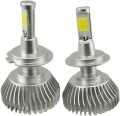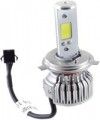Rated power
The power normally consumed by the lamp during operation. This parameter is often used to evaluate the overall brightness of the glow, especially in the case of lamps for headlights (see "Purpose"): such a specific parameter as the luminous flux, firstly, is less familiar to ordinary car owners, and secondly, in its characteristics are not always indicated. However, it must be remembered that only lamps of the same type (see above) can be compared with each other in terms of power consumption. different types can differ markedly in efficiency and luminosity. But what this indicator directly affects is the power consumption of the lamp and, accordingly, the load experienced by the generator or battery. Modern car lamps have a power of up to 100 W, such power consumption is normally tolerated by the on-board network in normal operation. However, the lower horsepower provides some fuel savings.
Voltage
Operating voltage of the auto lamp.
In different types of equipment, the voltage of on-board networks is also different. Therefore,
car lamps for passenger cars are designed for a voltage of 12 V, and
car lamps for trucks(and other similar equipment, such as buses) are designed for 24 V. However, there are also more specific options:
—
12/24 V. Lamps with the possibility of use in both types of on-board networks - both passenger cars and trucks. This versatility is found mainly among LED models, as well as in some types of xenon (see “Type”): these types of lamps are equipped with control circuits that can automatically adjust to the on-board network voltage.
— 85 V. Value found in models with xenon operating principle (see “Type”). In this case, we mean the voltage supplied to the lamp from the ignition unit (see below); the ignition unit itself is connected to the on-board network and is usually designed for 12 V. Data on the operating voltage of the lamp itself may be needed if you need to select a separate ignition unit for it.
- 40 V. Another option for increased voltage in xenon lamps; the meaning is completely similar to the 85 V described above, but is much less common.
Brightness
Luminous flux produced by a car lamp; for dual-mode models like bi-xenon (see “Type”), the value at maximum brightness is indicated.
This parameter characterizes the actual brightness and efficiency of the lamp; it can be used to directly evaluate and compare different models, regardless of their type and power consumption (but only at the same color temperature - see below for more details). The brightest are headlight lamps (see “Purpose”), in them this indicator can
exceed 4000 lm and vary noticeably from model to model. Therefore, when choosing such a lamp, you should pay special attention to the characteristics of the luminous flux. It should be borne in mind that too bright headlights are just as undesirable as too dim ones: high brightness creates not only the risk of dazzling for oncoming cars, but also discomfort for the driver himself. Optimal luminous flux values can be indicated in the documents for the car or for the headlight itself; if such data is not available, you can turn to other special sources.
As for other types of lamps, in models for auxiliary lighting the luminous flux is up to 800 lm, and in lamps for the instrument panel - up to 55 lm. Moreover, in both cases, the brightness is selected by the manufacturer taking into account the specific specialization and location of the lamp, so in such models this parameter is not a key one.
Lifespan B3
Guaranteed lamp life according to B3 standard. In fact, this is the longest time that the lamp can continuously work with a 97% guarantee (it is impossible to provide a 100% guarantee in principle). This parameter is measured as follows: a test batch of lamps is used until 3% of them fail, the resulting time is indicated in the characteristics.
Other things being equal, longer-lasting lamps naturally cost more, but longer service life compensates for this disadvantage. Separately, we note that you should not confuse the guaranteed service life with the manufacturer's warranty — the conditions and warranty period may be different even for lamps with the same B3.
Lifespan Tc
The maximum continuous lamp operation time. This indicator is quite approximate and the probability that the lamp will work during this period is approximately 1 in 3. This is due to the measurement technique: a control batch of lamps is used until 63.2% of them fail, the resulting time and indicated as "maximum service life". However, the Tc data compared to the B3 guaranteed life (see above) provides a good estimate of the overall lamp life and its ability to last beyond the guaranteed life.

